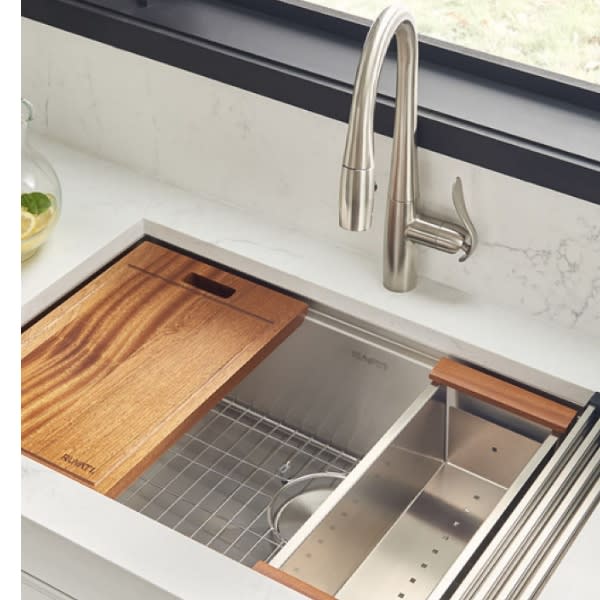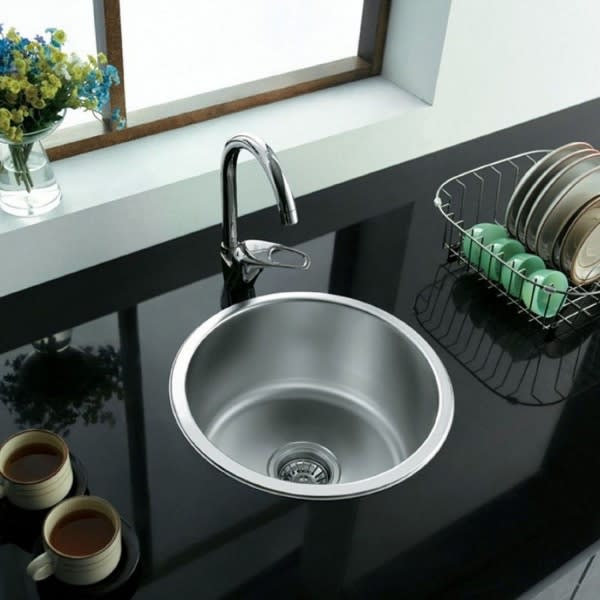Are you bending over too much to do dishes? Is your sink taking up too much counter space? Is your sink already crowded after a few dirty dishes? These are telltale signs that you have the wrong sink size.
The wrong kitchen sink size is a nuisance, increasing the risks of chronic back pain, dripping, messy counters, and broken dishes. These nuisances lead to costly repairs, replacements, and even medical bills down the road.
The right kitchen sink size also depends on the sink’s design, and not every sink is so easily replaced.
For example, if your integrated sink is the wrong size, you must remodel the kitchen counter.
That’s one reason why it’s so important for you (and your contractor) to nail down the right size before construction.
Avoid costly mistakes from the start. Remember these tips and tricks as you choose the ideal sink size for your kitchen!
Standard Kitchen Sink Sizes You Should Know
The ideal sink size depends on several factors, including height, physical needs, kitchen size, counter size, cabinet size, and design preferences. You must also consider sink upgrades, such as spray faucets, water filters, strainers, new plumbing, and sink organization accessories.
Despite these variables, there are general standard sink sizes to help you choose the ideal size for your needs. On average, customers who purchase single-bowl sinks prefer 30-inch-long dimensions at most.
Experts recommend at least 22 to 27 inches long, which also works for small kitchens.
For those with larger families or higher dishwashing needs, a double kitchen sink, which typically offers a larger size than a single-bowl sink, can be more convenient. It provides ample space for washing dishes and multitasking in the kitchen.
Length is one factor, but you also have to consider the depth of the sink.
Kitchen sinks should be at least 7 to 7.25 inches deep; anything less and your dishes will quickly pile up and reach the faucet. Heavy dish loads would benefit from 8 inches and up. If your sink is less than 7 inches deep, install a pull-out faucet or a faucet with a taller neck.
Standard sizes for single-bowl and double-bowl sinks are also different. Double-bowl sinks have two basins separated by a steel, marble, or granite divider or counter space if they’re integrated sinks. They require more room and can reach up to 48 inches long, while larger single-bowl sinks are typically 33 inches or less.
You can also install a 40-inch long oversized single-bowl kitchen sink with more depth, which is more accommodating for large families.
Standard sink sizes only tell you so much. You must adequately measure your kitchen and counter, consider your needs, and work with a contractor to determine the ideal size.
Why You Need a Properly Sized Sink
What about the needs of homebuyers?
Back and neck pain, lack of space, drippy sinks, and the risk of damage are a few reasons why proper sink sizes matter, but did you know that it’s crucial for home sellers?
According to recent real estate studies, almost 40% of homebuyers want homes that don’t require remodeling or renovations. The wrong sink size, especially if it’s an integrated sink, can scare off potential buyers, keeping your home on the market even longer.
Another study found that homebuyers regard kitchens as the #1 most important space in the home, which is reason enough to upgrade your sink before you sell. Expect buyers to consider kitchen sink sizes before making an offer.
Kitchen upgrades add considerable value to buyers’ homes. Let’s examine different kitchen sink designs to discover the right sink dimensions.
Types of Kitchen Sink Designs
Let’s start with the classic integrated sink. These sinks have a seamless look and incorporate well into various kitchen styles. You don’t have to worry about grime sticking to hard-to-clean rims and seams. While these sinks are found in millions of homes, they’re the most challenging sink to “resize.”
Unlike most sink designs, you can’t simply install a new sink. As you learned earlier, you must first replace the entire kitchen counter. That’s why these sinks are better for bathrooms than kitchens.
If you want to install an integrated sink, consider everyone’s needs in your household since these sinks are harder to replace. Deep basins are better for soaking dishes, but smaller members of your household may benefit from shallow sinks; this also applies to other kitchen sink styles.
Moving on to the farmhouse kitchen sink, which is celebrated for its unique design that combines both functionality and aesthetic appeal. These sinks come in various standard sizes, making it crucial to measure accurately for a proper fit, especially when replacing an existing sink.
Understanding farmhouse kitchen sinks’ dimensions and installation requirements is essential for ensuring they complement your kitchen’s design while providing the practical benefits they are known for.
Drop-In and Top-Mount Kitchen Sinks

Drop-in sinks, also known as top-mount sinks, have been growing in popularity for years due to their functionality and the variety of sizes available. These versatile drop-in kitchen sinks have features like pre-drilled faucet holes and easy installation, making them suitable for different kitchen spaces and requirements.
These sinks are the easiest to replace. Once you’ve outgrown your sink size, just drop in a larger size. Kitchen counters require minimal remodeling, except for a new sinkhole.
These sinks are installed from the top and don’t require professional installation for simple replacements. However, you may need a professional countertop contractor to cut the new sinkhole. You don’t need a new hole if your new sink has the same length and width as the previous model.
Drop-in sinks have visible rims, but some homeowners don’t like the look of them. Sink rims can trap stubborn food debris and gunk if they’re not watertight, but proper installation can prevent sink loosening.
As an alternative, you can try an under-mount kitchen sink. These are nice if you want a deeper sink size without the rims.
Under-mount kitchen sinks are also installed underneath the counter and kept in place with sink clips. These sinks are harder to install on your own than drop-in sinks.
Farmhouse Kitchen Sink Styles

Apron sinks get their name from the wall (or “apron”) that spills over the front sink counter. These are similar to drop-in sinks, except the front of the sink jets out beyond the counter.
These sinks, also called farmhouse sinks, are commonly found in farmhouse-style homes. Originally, they were simple basins mounted on top of freestanding counters or kitchen tables.
Since apron sinks protrude out from the counter, they can make sizing a little tricky.
Unlike other sink sizes, you must consider how far you want your sink to jet out. Since sink depth determines apron length, your apron could be as long as 10 inches.
Standard kitchen countertop sizes are also an average of 25 inches wide, so placement is critical for determining apron sink size. You don’t want your sink to protrude too far out or limit back counter space. Consider your kitchen’s dimensions when calculating placement and protrusion, too.
Apron (or farmhouse) sink sizes range from 20 inches long, which is perfect for small kitchens, to over 60 inches for large families or even triple-bowl designs. You can also buy apron sinks with attached drainboards, which require more counter space.
Double Bowl Sink with Drainboard

Drainboard kitchen sinks have convenient, attached drainboards. They are typically installed like drop-in or farmhouse sinks but come in under-mount styles.
Drainboard sink size ranges from simple to advanced with attached cutting boards and sink organization. Since these sinks come with multiple features, they require more counter space than regular drop-in sinks.
Best Sink Sizes for Small Kitchens
More Americans are squeezing into smaller kitchens, but this doesn’t have to limit your sink options.
Drainboard sinks with removable cutting boards work well in compact kitchens. They also come with drying attachments if your tiny kitchen doesn’t have a dishwasher.
Nearly every sink style works in small kitchens, as long as it is between 22 and 24 inches on average. Anything over 27 or 30 inches is too large. You also need to conserve as much counter space as possible.
When selecting a sink, consider the size of your kitchen sink cabinet and any necessary modifications, such as adjusting plumbing or lowering the pipe that feeds into the wall, especially when switching from a shallow sink to a deeper basin.
Since you have less space, single-bowl sinks may work better in your kitchen. If you want a double bowl and save space, you need smaller basins, leading to crowding in your sink.
Kitchenette Sinks

What if the smallest sink is too large for the tiniest of kitchens?
22-inch sinks may be too big for your tiny kitchen or kitchenette. This is frequently the case for old studio apartments and tiny homes.
Tiny kitchens would need a sink similar to a kitchen island sink or a “prep bar” sink. These small single-bowl sinks are just 15 inches long. You would also find these in a home bar.
Prep bar sinks are tiny, and dishes pile up quickly when you don’t have a dishwasher. If a 22-inch sink fits just fine, go for that or even a 24-inch if you can. See if your tiny kitchen will accommodate a deeper sink bowl, too.
Wall-Mounted Sinks

Another option for small kitchens is wall-mounted sinks. These sinks take up very little space and don’t even require counter space for installation. They simply mount onto the wall.
Wall-mounted sinks work great in small studios or lofts with open layouts. However, you would need to purchase additional upgrades, like freestanding counters, kitchen storage, and stoves.
Unless you’re experienced, wall-mounted sinks require professional installation. You also need additional plumbing fixtures
Alternatively, you could try a small “Macgyver” kitchen island. Macgyver Islands come with everything, including drawers, counter space, kitchen storage, trash bins, and small sinks. These work great in open kitchen layouts.
Round Sinks

Most kitchen sinks are rectangular, circular, or oval-shaped and take up less counter space. These types of sinks are more common in bathrooms, but an oval sink would allow extra faucets.
Corner Sink Sizing

The corner sink is a less common kitchen sink style that may suit your needs. This style features two sink basins positioned at an angle, forming a right angle. It’s technically a double-bowl sink.
These are in homes with square or rectangular kitchen islands and bars. They may also be found in some commercial kitchens.
Since these sinks fit into a corner, they save more counter space than some large double-bowl sinks. You may want to consider this style if you host a lot of people in your kitchen but don’t want an oversized sink.
Standard corner sinks’ “back” lengths are typically 36 or 42 inches, but the front-facing measurements are much smaller. A 36-inch corner sink is only 17 inches at the front, while a 42-inch sink is just 24 inches up front.
How to Find Your Kitchen Sink Size
Before considering a replacement, measuring the dimensions of your existing sink accurately is crucial. This includes the length, width, and depth, especially if you’re upgrading to a different style or size.
Before you buy a new sink, you’ll need to measure your current sink. A standard ruler is fine, but a flexible measuring tape is much easier.
If you’re replacing your sink with a drop-in sink with rims, start measuring from the outer lip of the sink, not the basin itself. If you have an under-mount sink, measure where the edge meets the counter.
Next, find the length of your sink. Fix your measuring tape to the left edge of the sink and stretch it over to the right; that’s your length.
To find the width, measure from the back edge of the sink to the front edge. To find the depth, measure from the top edge of the sink down to the bottom.
Add a few inches to your depth if you want a deeper sink replacement. 10 inches is a good size upgrade from 7 inches, for example.
Remember to measure your kitchen countertops, counter height, and cabinets to find the right proportions.
Sizing Tips and Adjustments
Your sink works with other kitchen elements to create a convenient layout.
If your overhead cabinets hang low, you’ll want to avoid faucet necks that are too high. Plus, if your kitchen counter height is too low, you’re likely straining yourself at the sink. Consider moving your overhead cabinets up and increasing the counter height to reduce back strain.
Likewise, consider lowering your kitchen counter height and overhead cabinets if they’re too high. You don’t want to risk any kitchen accidents.
When considering installing a larger sink, remember that it may require more counter space and adjustments to your kitchen cabinets to accommodate the increased size. This is especially important for families needing to manage a high volume of dishwashing.
Discover the Perfect Kitchen Sink Size
Don’t risk the consequences of the wrong sink size. Find the right measurements and sink style for your needs, whether you’re selling your home, downsizing to an apartment, or accommodating a large household.
Refer to this guide as you find the ideal size for your kitchen sink, or check out the blog for even more kitchen remodeling ideas.
Kitchen sinks and cabinets go hand in hand. Do you have the right fixtures for your remodel? Contact us today to learn more about our selections or book a free kitchen design consultation!







